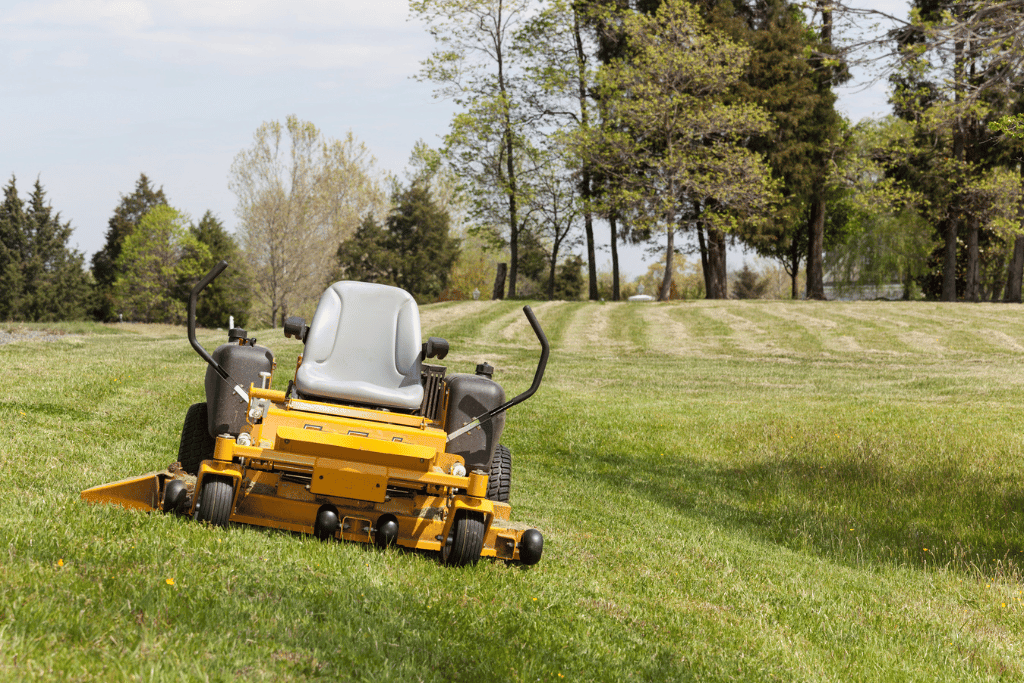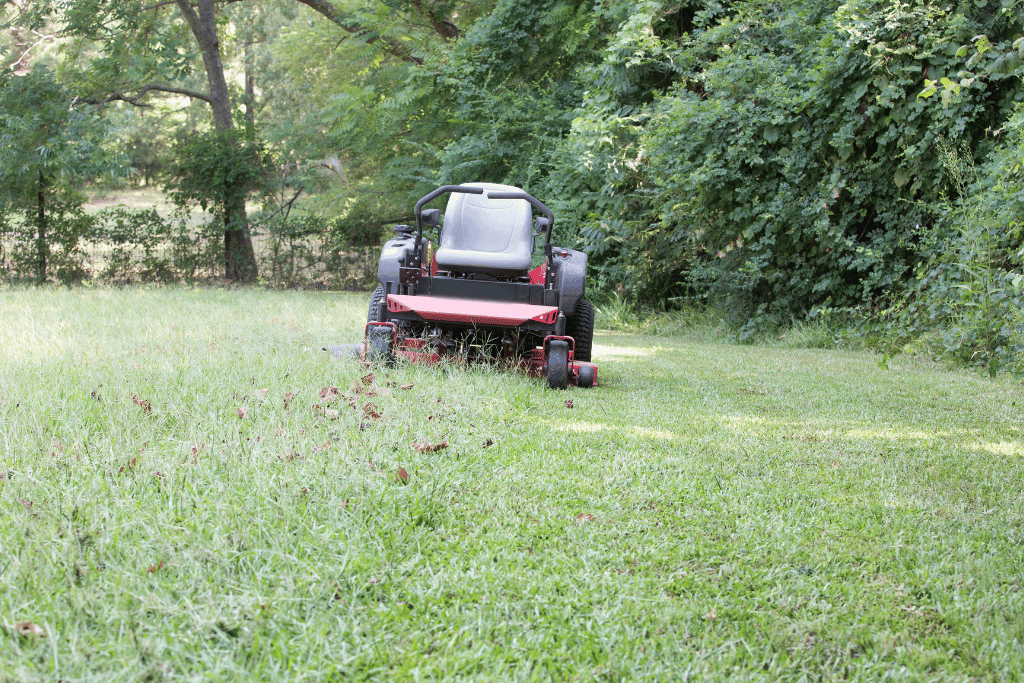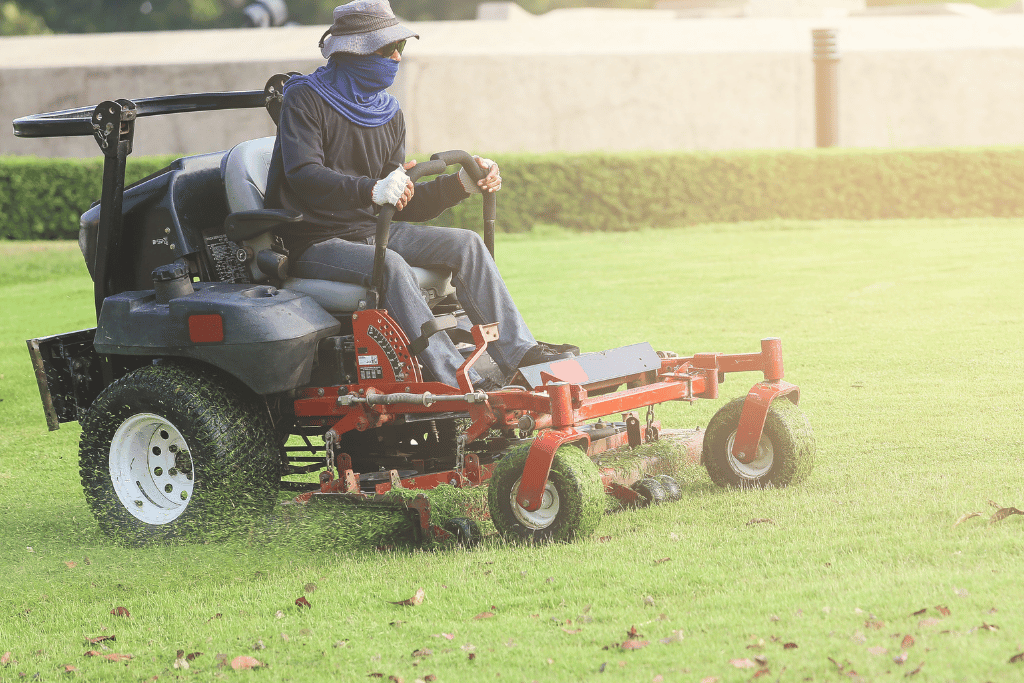
Zero turn mowers are remarkable machines designed for lawn maintenance. They boast an exceptional ability to make tight, zero-degree turns, offering efficient and precise grass cutting. With two handles to control each wheel individually, these mowers can pivot on the spot, making them popular choices for lawn enthusiasts.
However, despite their numerous advantages, there’s a significant downside to consider when operating them on hills. This article will be addressing the dangers of zero turn mowers on hills and provide valuable insights into preventing potential accidents.
Zero Turn Mowers Overview
Zero turn mowers are specialized lawnmowers uniquely engineered to execute sharp and nimble turns. These machines exhibit the remarkable capacity to pivot 360 degrees, thanks to their dual-handle control system. This enables them to mow with exceptional precision, making them an invaluable tool for lawn care enthusiasts.
Advantages of Zero Turn Mowers
The advantages of zero turn mowers are hard to overlook. They can significantly reduce the time and effort required for lawn maintenance, particularly in extensive outdoor spaces. Their unrivaled maneuverability enables them to navigate around obstacles effortlessly, ensuring a pristine and well-manicured lawn.
The Appeal of Hills for Mowing

Aesthetic and Landscaping
Hills within a lawn can offer an aesthetically pleasing and dynamic landscape. They add depth, texture, and character to the overall scenery, enhancing the visual appeal of the outdoor space. Moreover, they provide opportunities for creative landscaping designs and recreational activities.
Challenges Posed by Hilly Terrain
However, mowing on hilly terrain poses distinct challenges that need to be addressed. The uneven ground, combined with the slope of the hill, can make traditional lawn mowing methods less effective. This is where zero turn mowers come into play, promising a solution to these difficulties.
Why Zero Turn Mowers are Used on Hills?
Zero turn mowers are often chosen for hillside mowing due to their unique capabilities. They provide an opportunity to achieve professional-level precision and neatness, even on challenging slopes. Nevertheless, it is essential to be aware of the potential dangers of zero turn mowers on hills.
How Steep Can a Hill Be?
The steepness of a hill is a critical factor in determining whether it is safe to use a zero turn mower on it. Steepness is typically measured in degrees of incline, and it can significantly affect mower stability and operator safety.
Factors Influencing Steepness Limits
Several factors come into play when determining how steep a hill can be before it becomes hazardous for zero turn mower operation. These factors include the mower’s design, the operator’s experience, and the terrain’s condition.
Mild Hills (0-15 Degrees): Mild hills are those with a gentle incline, typically ranging from 0 to 15 degrees. On these hills, zero turn mowers can usually operate safely with minimal risk of tipping or losing control. However, it’s essential to exercise caution and employ proper mowing techniques even on mild slopes.
Moderate Hills (15-30 Degrees): Moderate hills have a more pronounced incline, ranging from 15 to 30 degrees. Mowing on these slopes becomes progressively riskier, and operators should be well-trained in handling zero turn mowers. Advanced mowing techniques may be required to maintain stability and avoid accidents on moderate hills.
Steep Hills (30+ Degrees): Steep hills are those with inclines exceeding 30 degrees. These hills present the highest level of risk when using zero turn mowers on hills. Mowing on steep slopes can lead to severe stability issues, increased chances of tipping, and potential accidents. In most cases, it is strongly discouraged to use zero turn mowers on hills of this steepness due to the heightened danger they pose.
Knowing hill steepness and its associated risks is essential for safe zero turn mower operation on hills. Operators should exercise prudence and adhere to industry guidelines when deciding whether to tackle hills of varying steepness.
Dangers of Zero Turn Mowers on Hills: Operation

Operating zero turn mowers on hills introduces a unique set of challenges that can pose significant dangers to both operators and equipment. While these mowers are celebrated for their efficiency on flat terrain, their remarkable maneuverability and speed can become liabilities when navigating slopes. It’s crucial to understand these dangers of zero turn mowers on hills thoroughly to ensure safe operation.
1. Loss of Stability
Perhaps one of the most prominent dangers of zero turn mowers on hills is the looming specter of stability loss. These machines, with their inherent design features, boast a relatively high center of gravity, which renders them susceptible to tipping when confronted with uneven terrain.
2. Tipping Risks
The center of gravity in zero turn mowers tends to be situated higher than in their conventional counterparts, a design that allows for their incredible maneuverability. However, this very characteristic elevates the risk of tipping over, especially on hills with irregular contours. Tipping accidents can result in a slew of dire consequences, ranging from operator injuries to extensive equipment damage.
3. Rollover Accidents
In the most severe instances, a loss of stability can lead to catastrophic rollover accidents, where the mower flips over onto its side or, in the gravest scenarios, completely overturns. Rollover incidents are particularly menacing due to their potential to cause severe bodily harm or even tragic fatalities, underscoring the urgency of addressing this inherent danger.
4. Maneuverability Challenges
While the exceptional maneuverability of zero turn mowers is an asset on level ground, it can swiftly transform into a bane when tackling hills.
Limited Traction:
On steep slopes, maintaining traction becomes an uphill battle. The mower’s wheels may struggle to grasp the terrain effectively, leading to worrisome instances of unintended sliding or outright loss of control.
Slipping and Sliding:
As the mower traverses the hill’s incline, it may succumb to the treacherous allure of sliding downhill, driven by the reduced traction. This involuntary sliding can pave the way for accidents, particularly when contending with steeper gradients.
Steering Difficulties:
Steering zero turn mowers on hills introduces a new level of complexity. Operators must deftly manipulate both handles to maintain a straight and secure path. A momentary lapse in control can lead to unwanted veering off-course or, worse yet, tipping over the precipice.
Speed Control:
Maintaining a consistent speed while ascending or descending hills with zero turn mowers presents a unique set of challenges that impact safety.
Difficulty in Maintaining Consistent Speed:
The hallmark feature of zero turn mowers, their ability to swiftly change direction and speed, can become a hindrance when contending with hills. Operators may find it demanding to sustain a steady pace, thereby heightening the potential for accidents.
5. Speed-Related Accidents:
Fluctuations in speed on hilly terrain can cause accidents, manifesting as sudden accelerations or decelerations.
These variations can snowball into scenarios where control is forfeited, increasing the likelihood of rollovers or other mishaps.
Brake Effectiveness:
Braking on hills with zero turn mowers can be an exercise in futility, further compounding safety concerns.
Challenges in Braking on Hills:
The very incline of a hill conspires against the efficacy of the mower’s brakes. Halting or slowing down on a slope can prove to be a protracted endeavor, well beyond what operators might anticipate. This delay can exacerbate the risk of accidents, rendering prompt responses difficult to execute.
Impact on Safety:
Diminished brake effectiveness on hills fundamentally compromises safety during zero turn mower operation. Operators may grapple with extended stopping distances, amplifying the inherent dangers associated with hillside mowing.
6. Uneven Cutting:
Using zero turn mowers on hills can result in uneven grass cutting, adversely affecting both the aesthetic quality of the lawn and the overall safety of the operation.
Scalping and Gouging:
When mowing on slopes, there’s an increased risk of scalping the grass (cutting it too short) or gouging the terrain, leading to an uneven and unsightly lawn. These imperfections mar the visual appeal of the landscape.
Potential Damage to the Mower and Terrain:
Uneven cutting not only detracts from the lawn’s appearance but can also inflict damage upon the mower’s blades and the underlying terrain. Such damage can precipitate costly repairs, adding a financial dimension to the safety concerns.
7. Operator Inexperience:
Inexperienced operators are particularly vulnerable to accidents when employing zero turn mowers on hills, emphasizing the critical importance of proper training and knowledge acquisition.
Lack of Training and Knowledge:
Operators who lack the essential training and knowledge may inadvertently engage in risky behaviors or, perhaps more worrisome, fail to recognize potential hazards. This can substantially elevate the likelihood of accidents, placing both themselves and the equipment at risk.
Operator Error as a Contributing Factor:
In many accidents involving zero turn mowers on hills, the human factor looms large. Operator error often plays a significant role, underlining the imperative need for comprehensive training and ongoing education to mitigate the attendant risks effectively.
Hill Mowing Techniques on Zero Turn Mowers and Their Advantages/Disadvantages

Technique 1: Straight Up-and-Down Mowing
This technique involves mowing directly up and down the hill, following the slope’s contours. While it may seem like the most straightforward approach, it has both advantages and disadvantages that deserve careful consideration.
Advantages:
- Simplicity: Straight up-and-down mowing is the simplest technique to grasp, making it accessible for operators of all skill levels.
- Minimal Risk of Tipping: When performed correctly, this method typically maintains a lower risk of tipping compared to other techniques.
Disadvantages:
- Inefficient Use of Maneuverability: Zero turn mowers are celebrated for their maneuverability, which isn’t fully utilized with this technique. The back-and-forth motion limits their ability to pivot effectively.
- Uncut Patches: Straight up-and-down mowing may leave uncut patches on the slope, requiring additional passes or adjustments to achieve a uniform cut.
Technique 2: Side-to-Side Mowing (Horizontal)
Mowing horizontally across the hill is another common technique. This approach offers better coverage of the hillside but introduces unique challenges.
Advantages:
- Improved Coverage: Side-to-side mowing provides better coverage of the hill, reducing the likelihood of missed spots.
- Reduced Risk of Scalping or Gouging: This technique often results in a more even cut, minimizing the risk of scalping or gouging the terrain.
Disadvantages:
- Increased Lateral Stress: Mowers experience increased lateral stress when mowing sideways on a hill, potentially straining the equipment.
- Risk of Sliding: The lateral movement can lead to sliding, especially on steeper slopes, which requires careful control to prevent accidents.
Technique 3: Diagonal Mowing
Diagonal mowing attempts to strike a balance between coverage and maneuverability, offering certain advantages while requiring advanced operator skills.
Advantages:
- Balanced Coverage and Maneuverability: Diagonal mowing combines coverage and maneuverability, making it a versatile technique for varied terrains.
- Reduced Risk of Tipping or Sliding: When executed correctly, diagonal mowing can minimize the risk of tipping or sliding on the hill.
Disadvantages:
- Advanced Operator Skills Required: This technique demands a higher level of skill and experience to maintain control and safety effectively.
- Challenges on Very Steep Slopes: Even with advanced skills, diagonal mowing may still present challenges on extremely steep slopes, necessitating additional precautions.
Technique 4: Contour Mowing
Contour mowing involves following the natural contour of the hill, which can minimize stress on the mower and provide a high-quality cut. However, it is a more complex technique that requires a good understanding of the terrain.
Advantages:
- Terrain-Friendly: Contour mowing adapts to the natural shape of the hill, reducing stress on the mower and promoting safety.
- Minimized Scalping and Gouging: This technique often results in a smoother cut with fewer incidents of scalping or gouging.
Disadvantages:
- Complex Execution: Contour mowing is a technique that demands skill and experience to execute correctly. Operators must be familiar with the terrain’s features and contours.
- Terrain Understanding Required: Successfully employing contour mowing necessitates a deep understanding of the hill’s topography, which may not be feasible for all operators.
When choosing a mowing technique for hills, operators should consider the terrain’s steepness, their level of experience, and the specific advantages and disadvantages of each method. Safety should always be the top priority, and using the most suitable technique for the situation is crucial to prevent accidents and ensure a well-groomed lawn.
Safety Tips While Using a Zero Turn Mower on Hills

Given the myriad dangers posed by operating zero turn mowers on hills, it is imperative to implement a comprehensive set of safety precautions and mitigation strategies to safeguard both the operator and the equipment. By adhering to these measures, the risks inherent to hillside mowing can be substantially reduced.
Proper Training:
Perhaps the single most critical safety measure when operating zero turn mowers on hills is providing operators with proper training. Comprehensive training programs should be designed to equip operators with the essential skills and knowledge needed to navigate the challenges of hillside mowing.
Understanding Mower Features
Training programs should encompass a thorough understanding of the specific features and capabilities of zero turn mowers, including their unique mechanisms and safety systems. Operators must be well-versed in the mower’s limitations and how to optimize its performance on hills.
Site Inspection Before Mowing
Prior to engaging in hillside mowing, a meticulous site inspection is imperative. Operators should conduct a detailed assessment of the terrain, taking into account its steepness, contours, and any potential hazards such as rocks, tree roots, or uneven ground.
Identifying Potential Hazards
Part of the terrain assessment involves identifying potential hazards that could compromise safety during mowing. This proactive approach allows operators to devise strategies to mitigate or circumvent these dangers.
Hillside Stability Features
Utilizing zero turn mowers equipped with specialized hillside stability features can significantly enhance safety during operation. These features may include enhanced wheel traction, lower center of gravity, and reinforced frames designed to withstand the rigors of hillside mowing.
Traction Enhancements
Incorporating traction enhancements, such as rugged tires designed for hillside use, can bolster the mower’s grip on the terrain, reducing the risk of sliding and loss of control.
Slow and Controlled Operation:
Maintaining a safe and controlled speed while operating on hills is paramount. Operators should resist the temptation to rush through the mowing process and prioritize steady, cautious progress.
Avoiding Abrupt Maneuvers
Abrupt or aggressive maneuvers should be avoided at all costs, as they can lead to loss of control, tipping, or rollover accidents. Operators should exercise patience and precision when navigating hills.
Knowing How to Respond to Accidents
Operators should be well-versed in how to respond to accidents promptly and effectively. This includes knowing how to shut off the mower, seeking medical attention if necessary, and contacting emergency services when the situation warrants.
First Aid and Communication Tools
Carrying essential first aid supplies and communication tools, such as a mobile phone or two-way radio, is essential for responding to emergencies swiftly. These tools can facilitate communication with emergency responders and provide immediate care in case of injuries.
Final Words
It is evident that the dangers of zero turn mowers on hills cannot be underestimated. These powerful machines, while highly efficient for flat terrain, pose significant risks when operated on slopes and inclines. The inherent instability, reduced traction, and potential for rollovers make them a hazardous choice for hilly landscapes.
The combination of high speeds and quick turns can easily lead to accidents, causing harm to both the operator and bystanders. To mitigate these risks, it is essential to exercise caution, adhere to safety guidelines, and, when possible, opt for more suitable equipment designed for hillside mowing.



